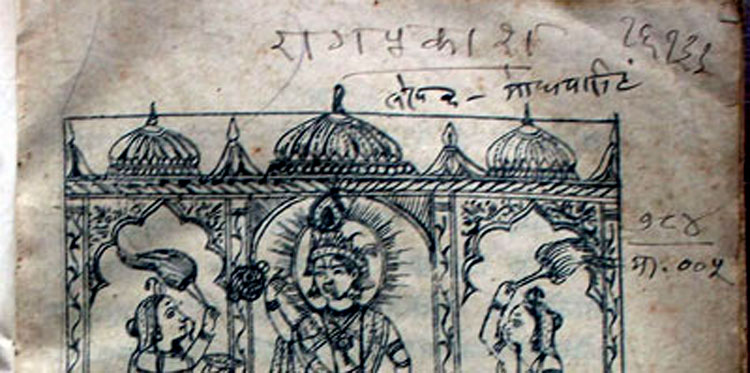About
Dhrupad is the oldest surviving form of Indian Classical music and traces its origin to the chanting of vedic hymns and mantras. Though a highly developed classical art with a complex and elaborate grammar and aesthetics, it is also primarily a form of worship, in which offerings are made to the divine through sound or nada. Dhrupad can be seen at different levels as a meditation, a mantric recitation, a worship, a yoga or tantra based on the knowledge of the nadis and chakras and also purely as a performing art portraying a universe of human emotions.

Dhrupad is a vocal tradition based on the practice of nada yoga, and is also performed on instruments like the Rudra Veena and the Sursringar. For the past five centuries Dhrupad has thrived primarily under the patronage of Mughal and Rajput kings. The picture above shows Dhrupad singers Zakiruddin Khan, Allabande Khan, Ziauddin Khan and Nasiruddin Khan (clockwise from top left) the foremost Dhrupad singers in the beginning of the twentieth century. The descendants of Zakiruddin Khan and Allabande Khan adopted the name of the genre, the Dagar Bani of Dhrupad, as their family name and acquired renown as the Dagar brothers.
They kept this art alive in the difficult period after 1947 when it lost the patronage of the royal courts. Zakiruddin and Allabande Khan were brothers and disciples of their grand-uncle Baba Behram Khan, and served respectively in the royal courts of Udaipur and Alwar. They were the foremost Dhrupad singers of their times (late nineteenth and early twentieth century) and were greatly respected for their singing and erudition. Their performances are still remembered with awe and reverence. Please see more details about Zakiruddin and Allabande and their descendants the Dagar Brothers here.
Although Dhrupad originated in the chanting of vedic hymns and mantras, it gradually evolved into an independent art form with its own complex grammar. Dhrupad was originally sung in temples and later thrived under the patronage of Mughal and Rajput kings. Fundamental to Dhrupad singing is the practice of Nada Yoga, in which, through various yogic practices, the singer develops the inner resonance of the body, and can make the sound resonate and flow freely through the entire region from navel to head. This enables the singer to produce a vast palette of subtle tone colours and microtonal shades. The processes of Udātta, Anudātta and Svarita play the same fundamental role in Dhrupad singing as in Vedic recitation.
A Dhrupad performance starts with the alap which is a slow and elaborate development of a Raga (mode) using free flowing melodic patterns. The elaboration of Dhrupad alap is done using the syllables of a mantric phrase 'om antaran twam, taran taaran twam, ananta hari narayan om'. The phrases of Dhrupad alāpa are very slow and contemplative in the beginning, but the tempo increases in stages, and in the faster passages playful and vigorous ornaments predominate. The audio and video samples on this site and Myspace give examples of different facets of Dhrupad. Dhrupad Alap is followed by the singing of a composition with rhythmic improvisation, to the accompaniment of a barrel drum called the pakhawaj (ancestor of the tabla).
The Tālas or cycles of beats commonly used are Choutala (12 beats), Dhamara (14 beats), Jhaptala (10beats), Sultala (10beats),Tivra (7 beats). In the videos on this page can be heard examples of Chowtal and Dhamar. Dhrupad portrays a vast range of human emotions: serenity, compassion, sensuality, pathos, strangeness, anger and heroism and subtle shades of them all. In Dhrupad of the Dagar tradition the notes are not treated as fixed points, but as fluid entities with infinite microtonal shades.The music is deeply spiritual and meditative. The Dagar style of Dhrupad is defined by 52 musical concepts or Arkaans (12 basic alankaras and 40 more). These include concepts like Udatta, Anudatta, Svarita, Sapta Gupta, Sapta Prakata, Sakari etc. which have all but disappeared from Indian classical music and even from Dhrupad . In the various audio/video files on this site can be heard all these concepts as they are used in practice in Dhrupad performance.
-
- Dhrupad Alap, Dhamar in Bageshree
- Alap in Raga Bihag
- Alap Yaman Shloka/Mantra Syllables
- Dhrupad Chowtal Raga Yaman
- Dhrupad Dhamar Raga Khamaj
- Dhrupad & Swedish Folk Kulning
- Kathak Dance With Vidyagauri Adkar
- Dhrupad & Odissi
- Raga Bageshree
- Documentary Dhrupad: The Call of the Deep Excerpt 1
- Documentary Dhrupad: The Call of the Deep Excerpt 2
-
- Baba Behram Khan
- Zakiruddin Khan
- Allabande Khan
- Ziauddin Khan
- Nasiruddin Khan
- Rahimuddin Dagar
- Imamuddin Khan
- Hussainuddin Dagar
- Nasir Moinuddin Dagar
- Nasir Aminuddin Dagar
- Zia Mohiuddin Dagar
- Rahim Fahimuddin Dagar
- Nasir Zahiruddin & Nasir Faiyazuddin Dagar
- Zia Fariduddin Dagar
- Hussain Sayeeduddin Dagar
- Dagar Brothers